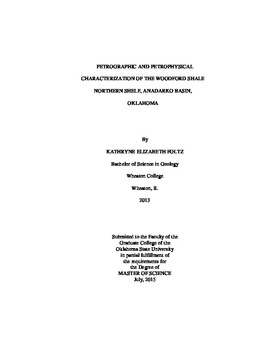| dc.contributor.advisor | Puckette, Jim | |
| dc.contributor.author | Foltz, Kathryne Elizabeth | |
| dc.date.accessioned | 2016-09-29T18:40:06Z | |
| dc.date.available | 2016-09-29T18:40:06Z | |
| dc.date.issued | 2015-07-01 | |
| dc.identifier.uri | https://hdl.handle.net/11244/45256 | |
| dc.description.abstract | This investigation of the Woodford Shale was prompted by observed variations in depositional and diagenetic content across the northern shelf of the Anadarko Basin in Oklahoma. Three cores, two from north-central Oklahoma and one from southern Kansas, were subdivided based on lithologic and geochemical properties. The two cores from Oklahoma contain three generalized, but distinct units: lower pyrite-rich, middle silica-rich, and upper carbonate-rich. Trace metal analyses including x-ray fluorescence and inductively coupled plasma mass spectrometry support the interpretation that the lowermost pyrite-rich interval was deposited in mainly anoxic to euxinic conditions. The middle silica-rich interval is composed of high frequency centimeter-scale silica-rich bands that represent the cyclical accumulation of radiolarians. The uppermost carbonate-rich interval contains increased deformation and features such as calcite-filled fractures and pyrite. Along with fluctuation in trace metal analysis, paleoredox conditions for this interval are interpreted as suboxic to anoxic. Centimeter-scale elemental analyses did not identify high-frequency deviations in concentrations of redox elements indicative of frequent disruption of water stratification. Instead, high-frequency measurement suggest relatively continuous stratification and the presence of an upper oxygenated layer that hosted radiolarian and algal populations that bloomed and collapsed, providing silica and organic matter that accumulated in the anoxic layer below. The silica-rich interval is recognized on gamma-ray logs by a decrease in API units and on porosity logs as suppression of neutron porosity, which represents decreased clay content compared to the surrounding subunits. The silica-rich interval may provide brittleness necessary for fracture propagation, but pore size and volume are greater in the pyrite-rich interval. The Woodford Shale from southern Kansas lacks the silica-rich interval and carbonate interval, and instead has two pyritic shale zones. The lack of the silica bands is attributed to the position of the Woodford distal to upwelling on the margin of the Ouachita Trough/Oklahoma Basin and the associated radiolarian blooms. | |
| dc.format | application/pdf | |
| dc.language | en_US | |
| dc.rights | Copyright is held by the author who has granted the Oklahoma State University Library the non-exclusive right to share this material in its institutional repository. Contact Digital Library Services at lib-dls@okstate.edu or 405-744-9161 for the permission policy on the use, reproduction or distribution of this material. | |
| dc.title | Petrographic and Petrophysical Characterization of the Woodford Shale Northern Shelf, Anadarko Basin, Oklahoma | |
| dc.type | text | |
| dc.contributor.committeeMember | Pashin, Jack | |
| dc.contributor.committeeMember | Hileman, Mary | |
| osu.filename | Foltz_okstate_0664M_14130.pdf | |
| osu.accesstype | Open Access | |
| dc.description.department | Geology | |
| dc.type.genre | Thesis | |
